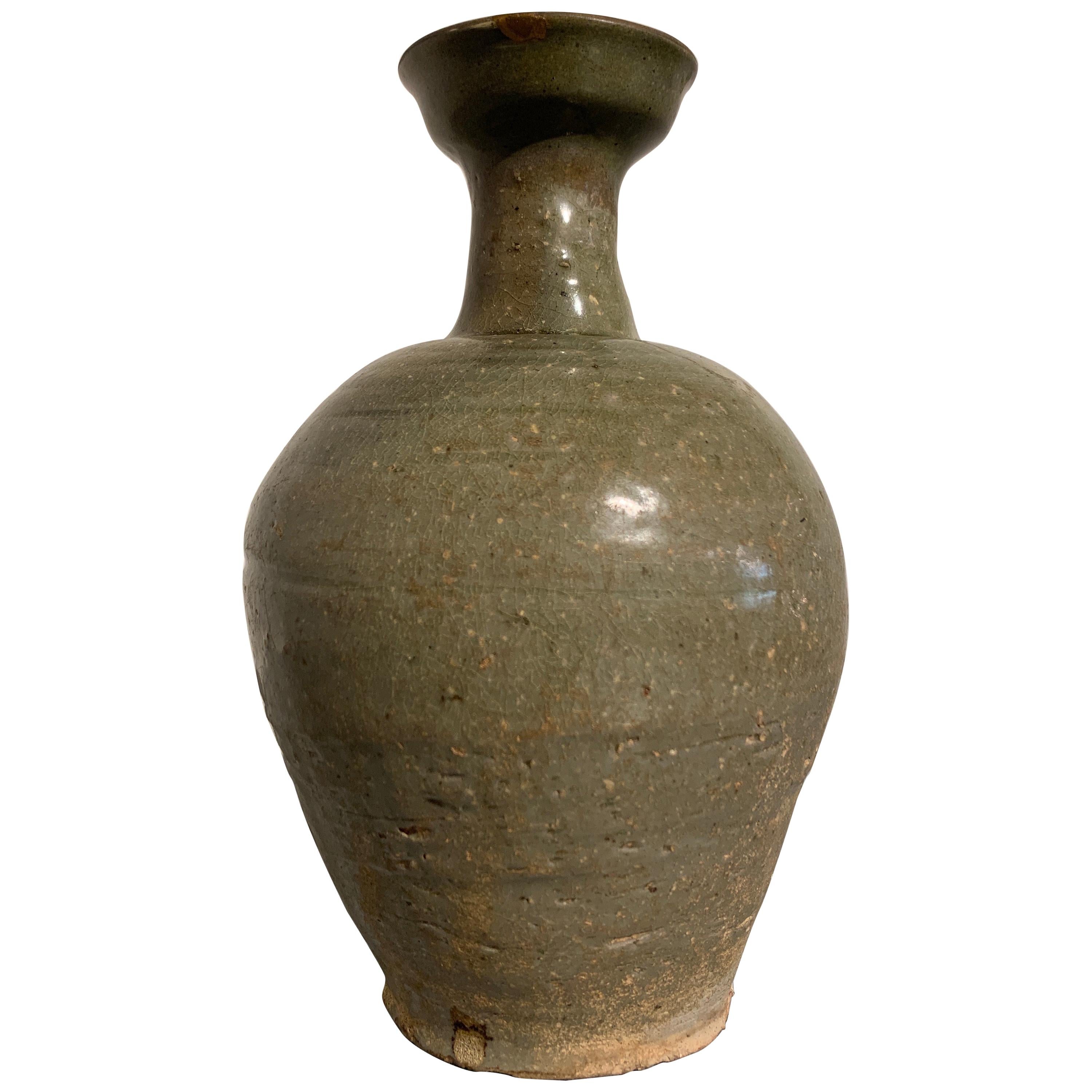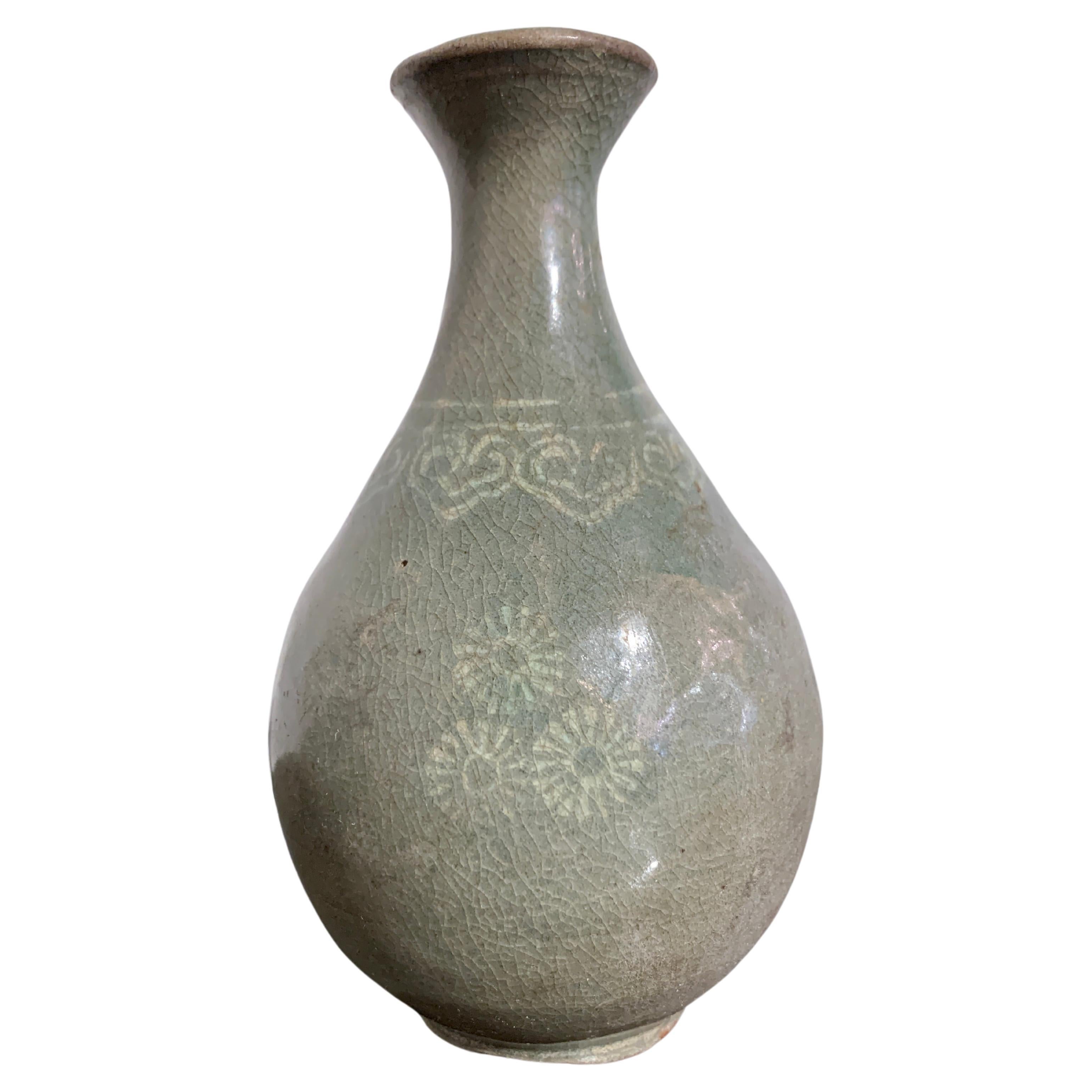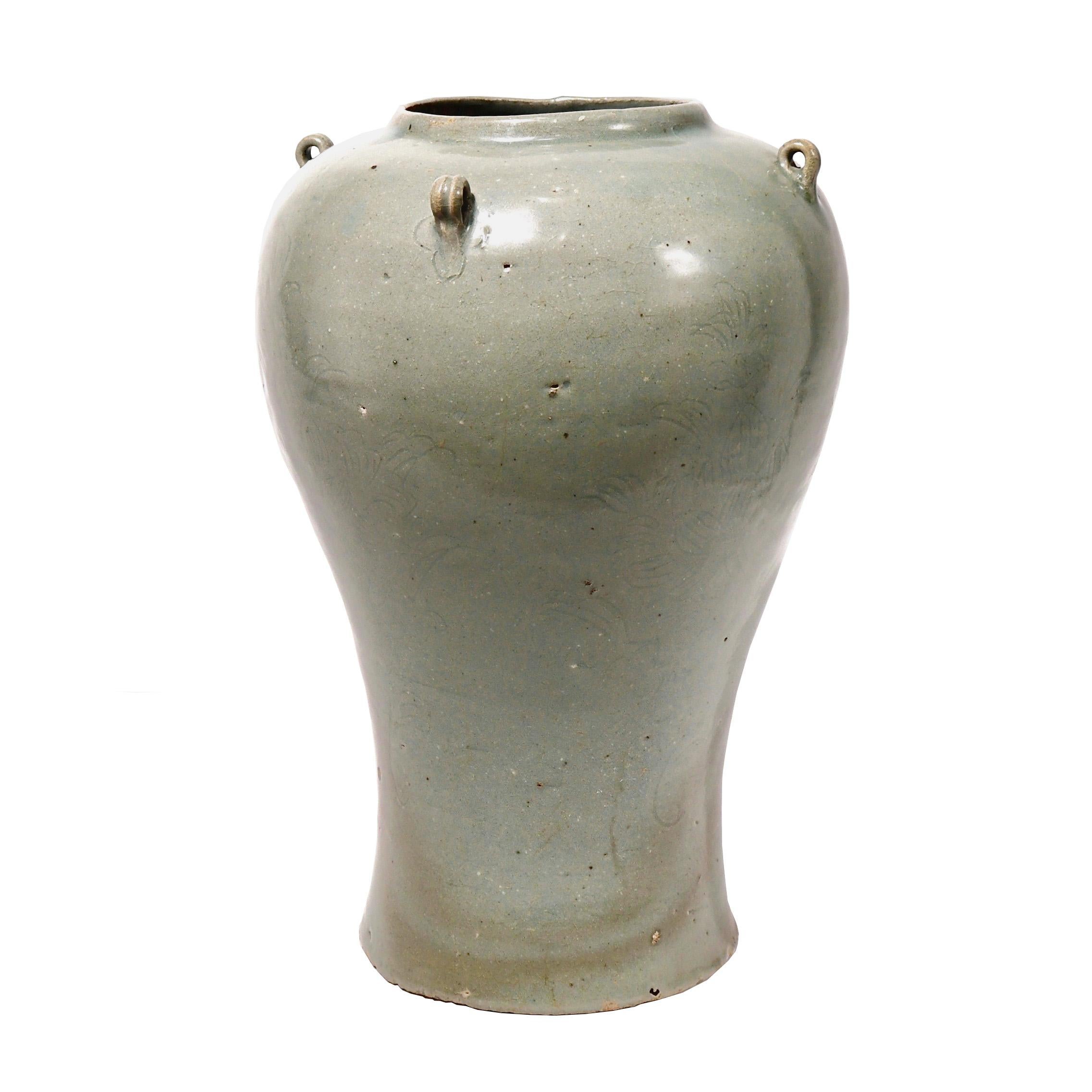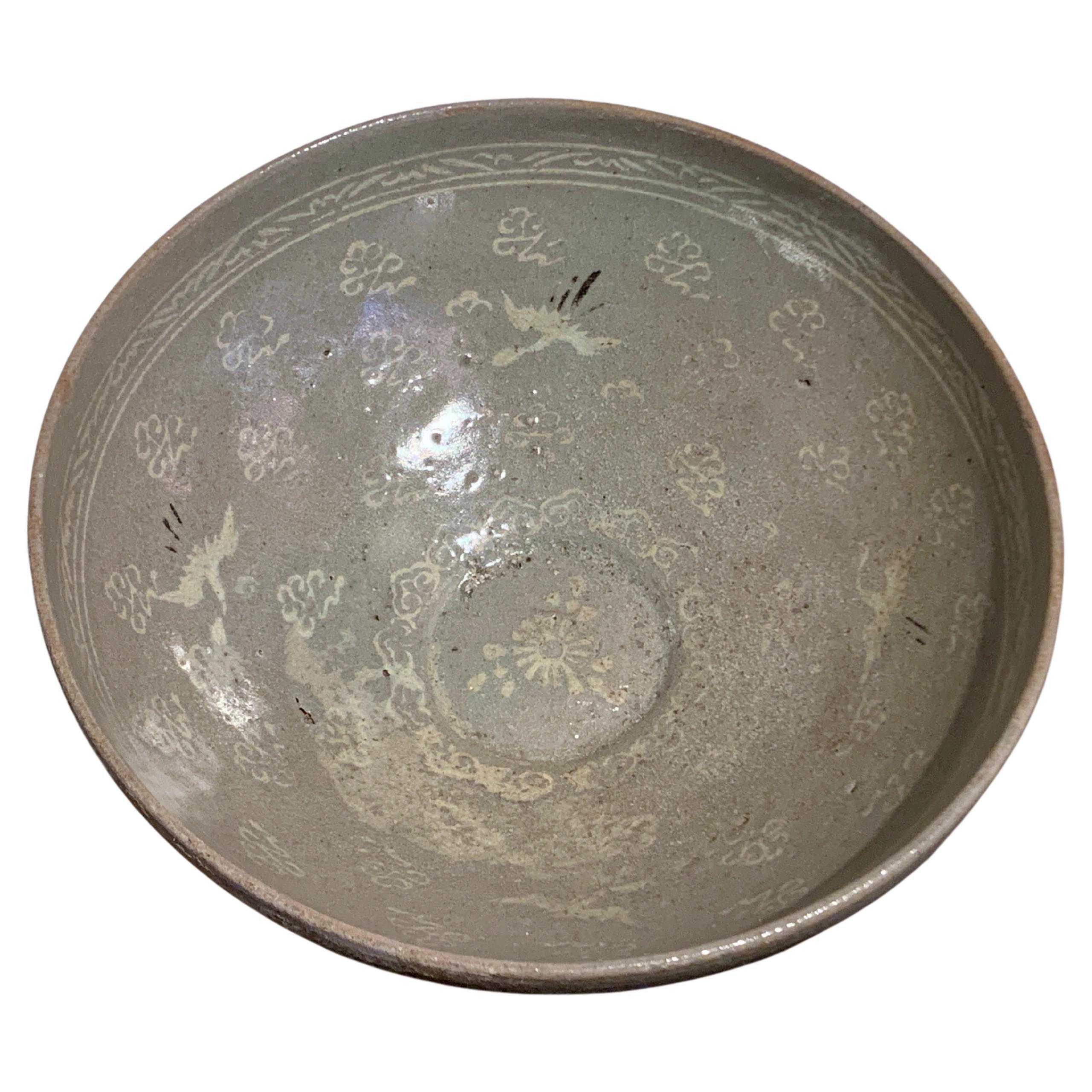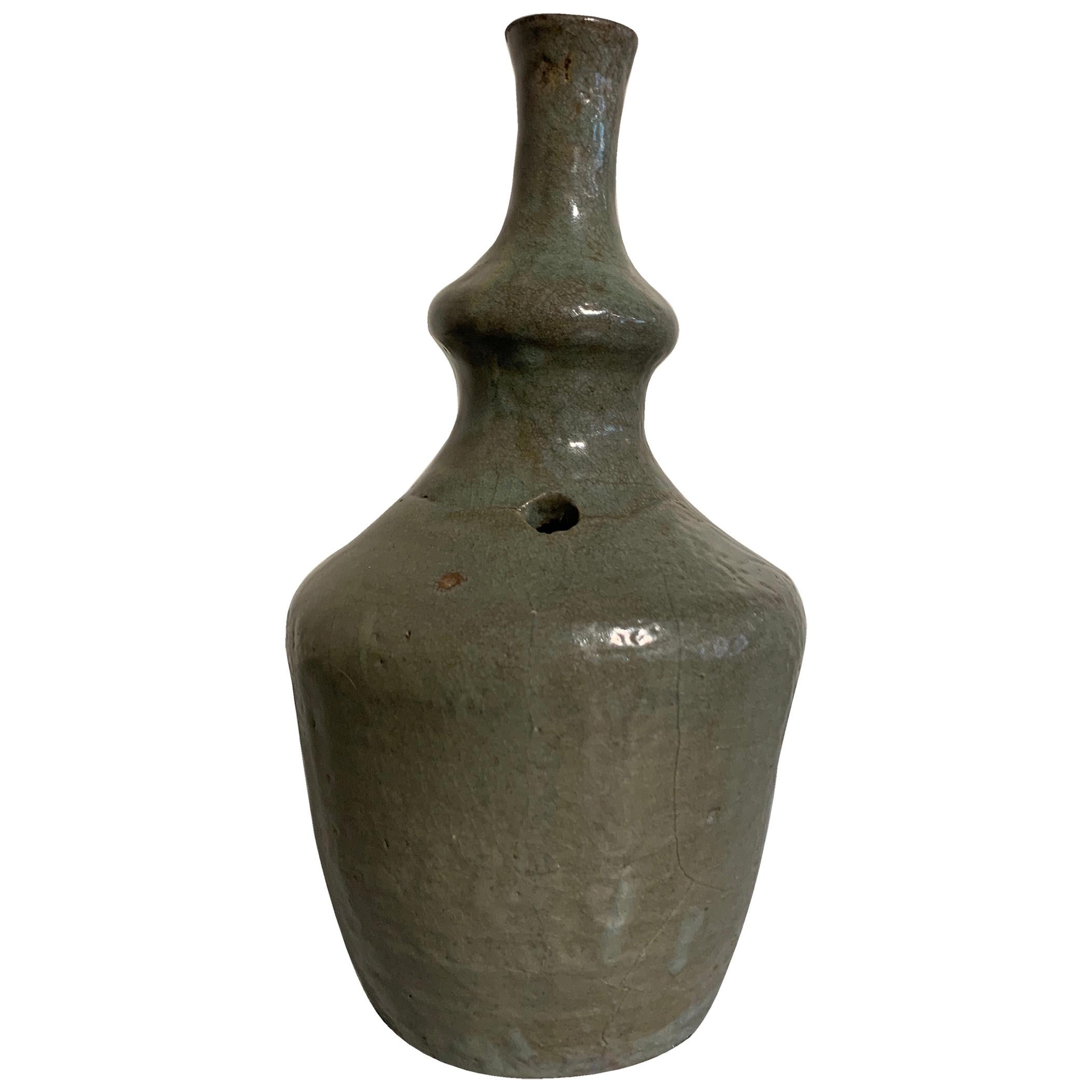Items Similar to Kundika Bottle Celadon with Incised Flower / 12th Century / Korean Antique
Want more images or videos?
Request additional images or videos from the seller
1 of 17
Kundika Bottle Celadon with Incised Flower / 12th Century / Korean Antique
About the Item
A "Johin" is a vase used to hold pure and clean water. According to the ancient Buddhist scripture "Lotus Sutra," it was originally one of the 18 tools that Buddhist monks were required to possess, but later came to be used as a vessel for offering clean water to the Buddha. During Korea's Goryeo period, it was also commonly used as a water storage container.
The vase is adorned with delicate floral patterns engraved with fine lines on its front and back. Among other Goryeo celadon Johin, this piece boasts exceptional glaze colors. Its form is graceful and its condition is superb, worthy of being displayed in a museum. A wooden box is included.
- Dimensions:Height: 11.03 in (28 cm)Width: 5.32 in (13.5 cm)Depth: 6.7 in (17 cm)
- Materials and Techniques:
- Place of Origin:
- Period:
- Date of Manufacture:918-1392CE
- Condition:
- Seller Location:Kyoto-shi, JP
- Reference Number:1stDibs: LU7673234132482
About the Seller
No Reviews Yet
Vetted Seller
These experienced sellers undergo a comprehensive evaluation by our team of in-house experts.
Established in 2012
1stDibs seller since 2022
- ShippingRetrieving quote...Ships From: Kyoto-shi, Japan
- Return PolicyA return for this item may be initiated within 2 days of delivery.
More From This SellerView All
- White Porcelain Vase / 17th Century / Korean Antiques / Joseon DynastyLocated in Kyoto-shi, KyotoThis product is a white porcelain bottle from the Joseon Dynasty. People in those days used bottles like this to make soap from waste oil. With use, the porcelain frayed and curle...Category
Antique 17th Century Antiquities
MaterialsCeramic, Porcelain
- Moon Jar / Korean Antique vase / Joseon Dynasty / 18th CenturyLocated in Kyoto-shi, KyotoIt's a wonderful moon jar. It is a rare size that is suitable for the alcove of a Japanese tea room. It is shaped at once without connecting the uppe...Category
Antique 18th Century Korean Antiquities
MaterialsCeramic
- Celadon Incense Burner with Peony Arabesque Design/Chinese Antique/14th-17th CLocated in Kyoto-shi, KyotoThis is a Celadon three-legged incense burner with peony arabesque design. Since the 14th century, Dwarf sedge was planted in this pot to decorate the tea room, so in Japan it is ...Category
Antique 15th Century and Earlier Antiquities
MaterialsCeramic
- Moon Jar 'Dalhanari', Lot3 / 17th Century / Korean Antiques / Joseon DynastyLocated in Kyoto-shi, KyotoThis is a white porcelain jar from the mid-Joseon period, also known as a "Talhunari" or "moon jar". During the Joseon Dynasty, which was strongly influenced by Confucianism, the purity of white porcelain was particularly prized in its artistic expression due to its Confucian sensitivity. The defining characteristic of white porcelain during this period was its pure white color, but there were many subtle variations in the white hues, with some being classified as milky white, snowy white, ashen white, and bluish white. The term "Talhunari" means "moon jar" in Korean, and it refers to the large, round shape of the jar, resembling a full moon. It was named by Kim Whanki, a representative abstract painter of Korea. The soft, curving lines and sturdy body that seems to embrace the full moon give the jar both power and tranquility. This type of jar was produced in large quantities during the 17th century. The white of the moon jar is not the pure white of early Joseon porcelain...Category
Antique 17th Century Korean Ceramics
MaterialsCeramic, Porcelain
- Moon Jar 'Dalhanari' - Lot2 / 17th Century / Korean Antiques / Joseon DynastyLocated in Kyoto-shi, KyotoThis is a white porcelain jar from the mid-Joseon period, also known as a "Talhunari" or "moon jar". During the Joseon Dynasty, which was strongly influenced by Confucianism, the purity of white porcelain was particularly prized in its artistic expression due to its Confucian sensitivity. The defining characteristic of white porcelain during this period was its pure white color, but there were many subtle variations in the white hues, with some being classified as milky white, snowy white, ashen white, and bluish white. The term "Talhunari" means "moon jar" in Korean, and it refers to the large, round shape of the jar, resembling a full moon. It was named by Kim Whanki, a representative abstract painter of Korea. The soft, curving lines and sturdy body that seems to embrace the full moon give the jar both power and tranquility. This type of jar was produced in large quantities during the 17th century. The white of the moon jar is not the pure white of early Joseon porcelain...Category
Antique 17th Century Korean Antiquities
MaterialsCeramic, Porcelain
- Longquan Celadon Plate / Chinese Antique / Song to Yuan Dynasty / 13th CenturyLocated in Kyoto-shi, KyotoThe Longquan kiln, situated in Longquan City of China's Zhejiang Province, thrived in the Song and Yuan eras. It is characterized by its beautiful green celadon ware, created by appl...Category
Antique 15th Century and Earlier Chinese Ceramics
MaterialsCeramic, Celadon
You May Also Like
- Korean Goryeo Celadon Glazed Bottle Vase with Kintsugi Repair, 12th CenturyLocated in Austin, TXA sublime Korean celadon glazed cup mouth bottle vase, Goryeo Dynasty, 12th century, Korea. The elegant bottle vase, originally used to serve wine, features a gorgeous Goryeo celadon...Category
Antique 15th Century and Earlier Korean Ceramics
MaterialsStoneware
- Korean Goryeo Celadon Glazed Slip Inlaid Bottle Vase, 12th/13th Century, KoreaLocated in Austin, TXA delightful small Korean Goryeo ware celadon glazed stoneware bottle vase with sangam slip inlay, Goryeo Dynasty, 12th - 13th century, Korea. The sma...Category
Antique 15th Century and Earlier Korean Ceramics
MaterialsStoneware
- Korean Celadon Jar with Four Handles. Goryeo dynasty, 12th century.Located in Point Richmond, CAKorean Celadon Jar with Four Handles. Goryeo dynasty, 12th century. A stoneware body of baluster form with bulbous high shoulder, four small strap ...Category
Antique 15th Century and Earlier Korean Other Ceramics
MaterialsCeramic, Celadon
- Korean Goryeo Celadon Glazed Sangam Inlaid Bowl, 12th/13th Century, KoreaLocated in Austin, TXA charming Korean celadon glazed stoneware bowl with white and black sangam inlay, Goryeo Dynasty, 12th - 13th century, Korea. The celadon glazed stoneware bowl of generous propor...Category
Antique 15th Century and Earlier Korean Ceramics
MaterialsStoneware
- Korean Celadon Glazed Ritual Ewer, Kundika, Goryeo Dynasty, 13th-14th CenturyLocated in Austin, TXAn understated and very heavily potted celadon glazed Korean ritual ewer or water sprinkler, kundinka, Goryeo Dynasty, 13th-14th century. The unusu...Category
Antique 15th Century and Earlier Korean Ceramics
MaterialsStoneware
- Antique Korean Buncheong Flat Bottle Vase with Incised DesignsLocated in Atlanta, GAA Korean Buncheong stoneware vase circa 15th century of Joseon Dynasty. The robust vase with thick walls was made in a bottle form with rounded square contour and flattened surfaces....Category
Antique 15th Century and Earlier Korean Archaistic Ceramics
MaterialsCeramic
Recently Viewed
View AllMore Ways To Browse
Used Antique
Antique Camers
Antique Camer
Storage Container
Antique Museum Display
Antique Glaze Colors
Antique Tool Display
Antique Buddhist
Antiques Flower Wooden
Antique Ceramic Flower
Antique Bottles Other
Antique Wooden Tool
Antique Water Containers
Antique Wooden Storage Box
Antique Wooden Storage Box Boxes
Antique Storage Containers
Antique Wooden Tools
Antique Bottle Display
